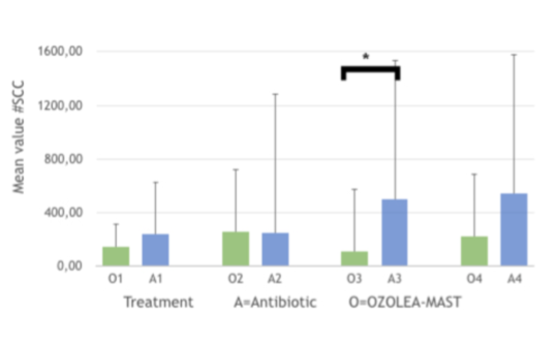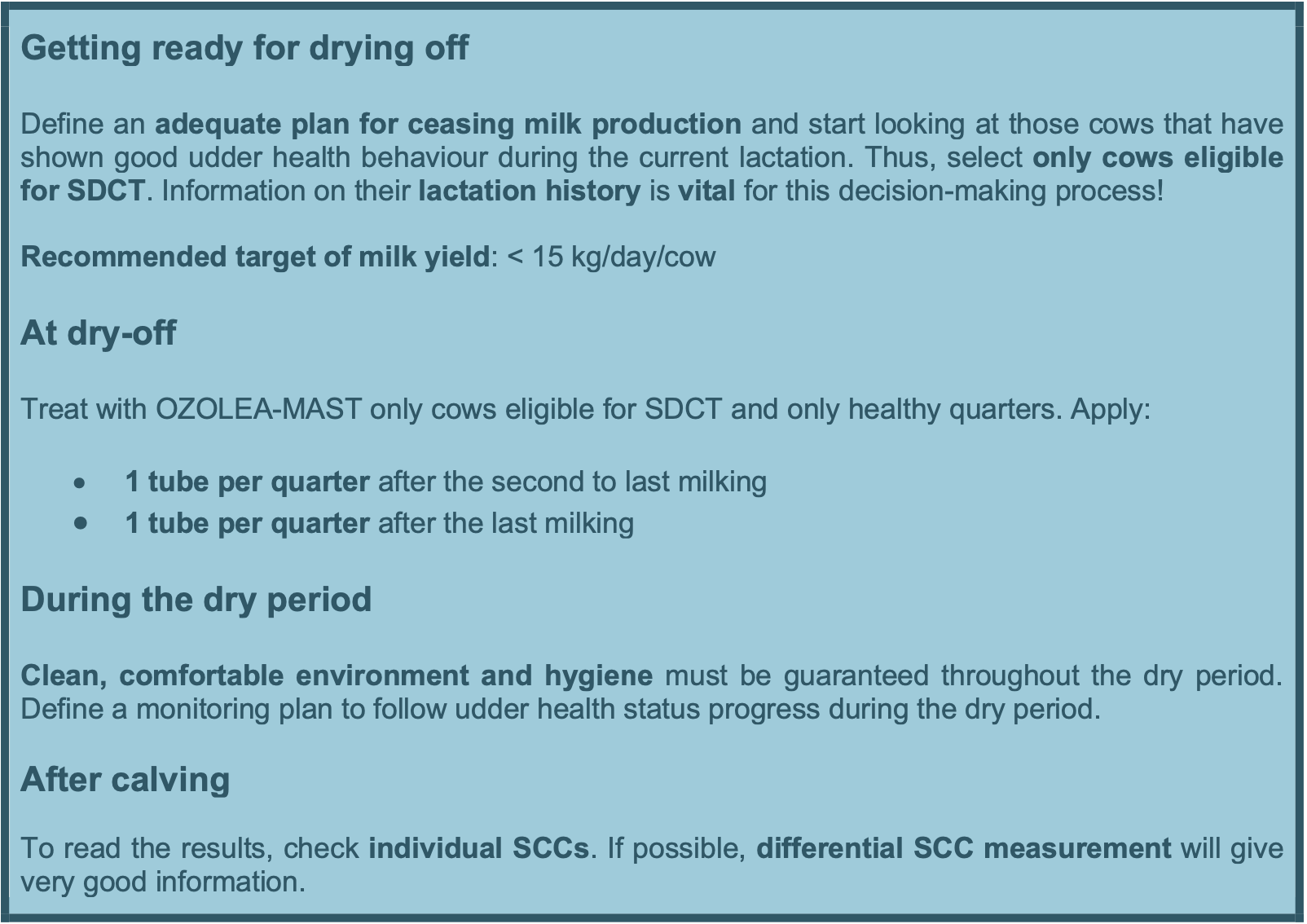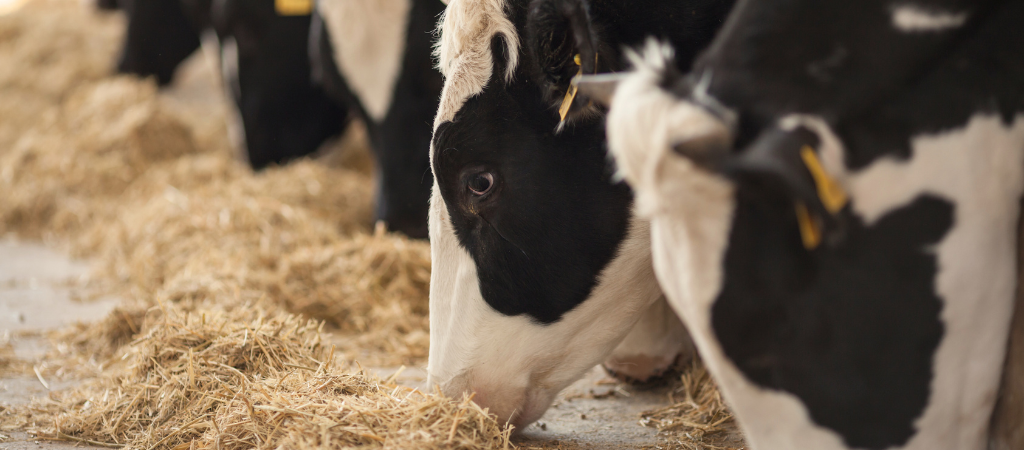Protocol M8 gives indications on the use of OZOLEA-MAST to dry off cows. Using OZOLEA-MAST at dry-off means more milk, better milk quality, improved cow’s performance, and easier management in future lactations.
OZOLEA-MAST for drying-off: why a double treatment?
Today, dairy farmers are called upon further effort to implement overall preventative strategies against antimicrobial resistance (AMR). Moreover, in the EU, antibiotic use at dry-off is now possible only when cows have shown mastitis and udder health issues during the current lactation. Prevention of new intra-mammary infections (IMI) through prophylaxis is no longer possible. Thus, selective dry cow therapy (SDCT) is the right approach.
One of the most frequently asked questions on OZOLEA-MAST is about the reasons why dairy farmers should use it at dry-off. OZOLEA-MAST at dry-off is the answer to the increasing requests for better management on farms and to the need of antibiotic reduction.
The exclusive technology OZOLEA uses to process raw corn germ oil to produce OZOLEA-MAST leads to modification of some of the oil’s fatty acid chains, thereby allowing the product, once in contact with the inner wall of the teat canal, to form a physical film barrier with two main functions:
- to create an uncomfortable environment for bacteria and, thus, to slow down the aggressiveness of possible bacterial attacks;
- to exert a self-protection for the tissue from exposure to the external environment and from bacterial attack, allowing the tissue to proceed with the natural regeneration process.
OZOLEA-MAST does not carry out pharmacological, metabolic, or immunological action, and it does not treat, cure or prevent mastitis and IMI in dairy animals.
At dry-off and during the dry period, the mammary tissue goes through a physiological process to prepare for all its future functions, including milk production and self-defense. Thus, tissue functionality and integrity are directly involved in self-defence mechanisms and production performance.
By supporting tissue functionality, OZOLEA-MAST allows the mammary tissue to proceed with the autonomous regeneration process at the last two milkings and to complete it during the dry period. Moreover, dairy cows are genetically designed to produce their natural self-defence strategy against potential IMI: the keratin plug (physical barrier to pathogens trying to enter the teat canal) and natural protective factors against infections.
OZOLEA-MAST simply puts nature against nature, with no use of active substances. Natural processes do not occur instantaneously: this is why OZOLEA-MAST needs to be applied twice at dry-off.
What OZOLEA-MAST allows farmers to achieve in the dry period is the combination of natural keratin plug, autonomous production of protective factors, udder health monitoring, and effective environmental management. This is all what the strategy against AMR is asking dairy farmers for.
OZOLEA-MAST for drying-off: what benefits?
The medium- and long term benefits are several.
The individual somatic cell count (SCC) in the future lactation will tend to maintain lower, and steadier values for at least 4 months, also depending on the last SCC before drying-off. This is the outcome of a field study conducted in 2017 on 30 cows dried off with OZOLEA-MAST (Group O, Figure 1) and compared with other 30 cows that were dried off through a blanket dry cow therapy (BDCT) (Group A, Figure 1). All cows were suitable for SDCT, and the last SCC measured before drying-off was <400,000 cells/ml.
 OZOLEA observed a carry-over effect from the time of drying-off throughout the first 4 months of lactation, allowing dairy farmers to reduce antibiotics at dry-off. Moreover, in the third and fourth months after calving, there was a statistically significant difference between SCC scores measured in cows treated with OZOLEA-MAST (108,870 and 219,910 cells/ml, respectively for month 3 and 4) and those for cows treated with BDCT (501,830 cells/ml and 546,640 cells/ml, respectively for month 3 and 4), which indicates also better performance in terms of udder health. Group O showed SCC values around 200,000 cells/ml for the first four months after calving.
OZOLEA observed a carry-over effect from the time of drying-off throughout the first 4 months of lactation, allowing dairy farmers to reduce antibiotics at dry-off. Moreover, in the third and fourth months after calving, there was a statistically significant difference between SCC scores measured in cows treated with OZOLEA-MAST (108,870 and 219,910 cells/ml, respectively for month 3 and 4) and those for cows treated with BDCT (501,830 cells/ml and 546,640 cells/ml, respectively for month 3 and 4), which indicates also better performance in terms of udder health. Group O showed SCC values around 200,000 cells/ml for the first four months after calving.
Behind steadier and long-lasting SCC values, there is a functional and intact mammary tissue, able to sustain good milk production performance for longer periods. Furthermore, the epithelium at mammary level is functional and intact, thus allowing proper self-defence mechanisms: this is particularly relevant in first post-partum periods, when susceptibility to infections and udder problems.
Improving SCC values also means more profit: in Ireland, Geary and colleagues (2013)1,2 calculated an increase of the national dairy industry profitability by € 37.7 million per year by reducing SCC by 10%. OZOLEA-MAST is a strategy to improve profit, both at dry-off and in lactation. In addition, lower SCC levels are correlated by scientific research to better milk quality.
SCC is used by dairy farmers for culling decision-making processes. With the innovative approach of OZOLEA-MAST, farmers can work on SCC management both at dry-off, as we have seen above, and during lactation. Cows with lower SCCs, close or below the farm’s target threshold, will be maintained in the herd for longer periods, with consequent reduction of culling rates and improvement of cow’s longevity. Long-aging, high performing cows will better contribute to overall farmers’ profit as there will be less need of replacement heifers (so, optimised costs).
Concerning AMR, resistant strains on dairy farms have been a hard challenge. However, genes associated with resistance in microorganisms are lost when there is no antibiotic substance insisting on the microbial population. This means that, as OZOLEA-MAST is non-antibiotic and is applied along with effective herd management strategies, its use over long periods can lead farmers to reduce both antibiotic usage and the occurrence of cases caused by resistant pathogens, thus contributing to the fight against AMR. In this ever challenging environment, OZOLEA-MAST gives multiple long-term benefits in a changing and increasingly demanding dairy environment.
OZOLEA-MAST double treatment at dry-off is aimed at allowing natural physiological processes autonomously. This requires time, for this reason the application must occur twice. As we have seen above, medium- and long-term benefits are several: a smaller effort for a long-standing dairy vision.
How to apply OZOLEA-MAST at dry-off: Protocol M8

References
1 A. Naranjo-Lucena, R. Slowey, Invited review: Antimicrobial resistance in bovine mastitis pathogens: A review of genetic determinants and prevalence of resistance in European countries, Journal of Dairy Science, Volume 106, Issue 1, 2023, Pages 1-23, ISSN 0022-0302. DOI: https://doi.org/10.3168/jds.2022-22267
2 U. Geary, N. Begley, F. McCoy, B. O’Brien, L. O’Grady, L. Shalloo. Estimating the impact of mastitis on the profitability of Irish dairy farms. Ir. J. Agric. Food Res., 52 (2013), pp. 221-228. DOI: https://doi.org/10.3920/978-90-8686-742-4_36
3 M.J. Vilar, P.J. Rajala-Schultz, Dry-off and dairy cow udder health and welfare: Effects of different milk cessation methods. The Veterinary Journal 262 (2020) 105503. DOI: http://dx.doi.org/10.1016/j.tvjl.2020.105503

